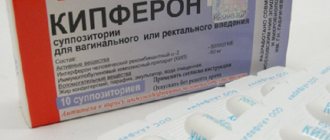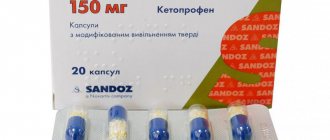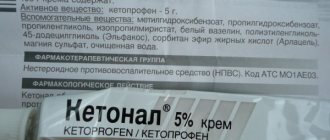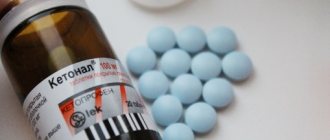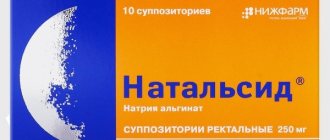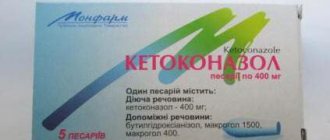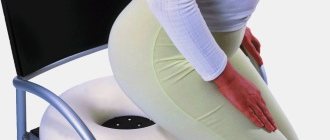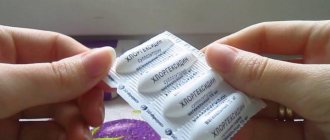Dosage form, composition, packaging
The product is available in the form of rectal suppositories. Externally they are bullet-shaped, white, uniform in consistency, smooth.
Each suppository includes a medicinal substance - ketoprofen 100 mg and additional components to facilitate the administration procedure: solid fat, glyceryl caprylocaprate.
Ketonal suppositories are contained in a cardboard package with two foil strips of 6 suppositories each.
There are different forms of release of Ketonal:
- in the form of tablets of 100 and 150 mg;
- capsules 50 mg;
- in ampoules for intravenous and intramuscular injections of 50 mg/ml - 2.0 ml;
- in the form of a patch;
- in the form of a cream for external use.
Warming patch
Capsules
Cream
Ampoules for injections
Rectal suppositories
Pills
Compound
- Solution - ketoprofen , propylene glycol, ethanol, benzyl alcohol, sterile water.
- Gel - ketoprofen, trolamine, carbomer , ethanol, lavender essential oil, sterile water.
- Cream - ketoprofen, isopropyl myristate, methylhydroxybenzoate, propylene glycol, propylhydroxybenzoate, white petrolatum, magnesium sulfate, elphacos ST9, propylene glycol oleate, glyceryl, water.
- Tablets - silicon dioxide, magnesium stearate, talc, corn starch, lactose, macrogol , hypromellose, titanium dioxide, indigo carmine, wax, talc.
- Capsules - ketoprofen, microcrystalline cellulose, lactose monohydrate, croscarmellose sodium, povidone, polysorbate, purified water, eudragit, triethyl citrate, talc, yellow iron oxide, purified water, silicon dioxide, titanium dioxide, gelatin.
- Suppositories - ketoprofen, solid fat, glyceryl caprylocaprate.
Pharmacological properties
The mechanism of action of Ketoprofen is due to blocking the cascade of inflammatory reactions. The body contains enzymes responsible for the inflammatory process: cyclooxygenase types 1 and 2, lipoxygenase.
Activation of these enzymes to an irritant triggers the production of mediators of inflammation and pain (prostaglandin, bradykinin, prostacyclin and thromboxane).
The point of application of Ketoprofen is the blocking of COX-1 and COX-2 and, accordingly, the rupture of subsequent reactions, and, as a result, a reduction in the source of inflammation, suppression of pain, and relief of the human condition.
It is important to note that cyclooxygenase exists in several forms. COX-1 is constantly present in the human body.
It is a catalyst for the synthesis of prostaglandin , prostacyclin, thromboxane, which trigger the physiological reaction of the body: regulate vascular tone and microcirculation, are responsible for tissue regeneration, namely the mucous membrane, and regulate kidney function.
COX-2 is synthesized in the body only during inflammation , therefore, the anti-inflammatory, analgesic and antipyretic effect of the Ketonal suppository is mainly associated with its inhibition.
Pharmacokinetics
Ketonal is easily absorbed through the mucous membrane of the digestive tract , which indicates its bioavailability - 71–96%. Ketonal has a high degree of binding to plasma proteins (99%), which must be taken into account when prescribing other drugs.
When using suppositories, the peak concentration of the drug Ketonal in the blood is determined after 1.5 hours. Ketonal is metabolized in the liver. The clinical effect lasts about two hours. Excreted: up to 80% by the kidneys in the form of glucuronide, the rest in unchanged form with feces.
Pharmacodynamics and pharmacokinetics
Pharmacodynamics
Ketoprofen inhibits the activity of cyclooxygenase , which inhibits the process of prostaglandin .
The drug also inhibits the synthesis of bradykinin , lipoxygenase , stabilizes lysosomal membranes in the cell and suppresses the production of enzymes that are involved in the inflammatory process. Ketoprofen does not have a negative effect on the condition of articular cartilage.
Pharmacokinetics
The process of absorption of ketoprofen in the body is very slow and it practically does not accumulate in the body. Bioavailability - 5%. The drug penetrates well and reaches therapeutic concentrations in synovial fluid, muscles, ligaments, and subcutaneous tissue. Its concentration in blood plasma is insignificant. Metabolized in the liver to form conjugates. Excreted in urine. Slowly.
Indications for use
Ketonal suppositories are a non-hormonal anti-inflammatory drug and the purpose of its administration is the symptomatic treatment of pain and inflammation:
- toothache, cephalalgia (headache);
- intercostal neuralgia, peripheral nerves;
- plexopathy, pain in the cervical and thoracic spine, in the lumbosacral region with dorsopathies;
- complex therapy of inflammatory diseases in gynecology (painful menstruation, pelvic pain with endometriosis);
- pain due to cystitis without signs of bleeding;
- for pain relief after operations (after childbirth, cesarean section, after abortion, aspiration biopsy, insertion of intrauterine contraceptive devices, diathermocoagulation, curettage for the purpose of diagnosis or treatment (LDV);
- pain relief in cancer patients;
- renal colic;
- Considering Ketonal’s good ability to penetrate and accumulate in joint fluid, one of the indications is degenerative-dystrophic and autoimmune diseases of the musculoskeletal system (polyarthritis, osteoarthritis, rheumatoid arthritis, gout, ankylosing spondylitis, arthritis in psoriasis, periarthritis, reactive arthritis, bursitis, tenosynovitis , glenohumeral syndrome);
- hemorrhoids without signs of bleeding;
Nuances of use
In gynecology
Ketonal is widely used for the treatment of various female diseases that are inflammatory in nature. The medicine is widely used after manipulations such as abortions, endoscopic interventions and operations.
Using the medicine during menstruation is strictly prohibited. If the patient experiences menstruation, the course of treatment must be suspended until it ends.
During pregnancy and lactation
Since the components of the medication are able to penetrate the placental barrier, the use of suppositories by a woman during pregnancy is strictly prohibited. You should not use the medicine while breastfeeding newborns.
After cesarean section and childbirth, taking the medication is strictly prohibited.
For prostatitis
The medicine can fight a variety of inflammatory processes. That is why it is widely used to treat prostatitis. Also, with its help, the consequences of this disease are eliminated.
In childhood
If the child’s age is less than 14 years, then using the medication for its treatment is strictly prohibited.
Contraindications
You should refrain from taking the drug if you have the following symptoms:
- intolerance to ketoprofen, auxiliary components of the drug, other non-steroidal anti-inflammatory drugs of the same group;
- “aspirin” asthma at any stage;
- allergic rhinitis, a history of skin manifestations as a result of taking aspirin or other NSAIDs;
- ulceration (ulceration) of the gastric or duodenal mucosa;
- gastrointestinal bleeding (tarry black stools, vomiting blood);
- inflammatory bowel diseases (ulcerative colitis, Crohn's disease);
- abnormalities in the hemostatic system (hemophilia, disaggregation thrombocytopathy, thrombocytopenia, hemorrhagic vasculitis, coagulopathies);
- children under 15 years of age;
- dysfunction of vital organs (liver and kidneys);
- cardiac failure in the decompensation stage (CHF 2B-3 stage, NYHA FC 3-4);
- to alleviate the condition after bypass surgery and stenting of the coronary arteries;
- pregnancy 3rd trimester and breastfeeding period;
- inflammatory diseases in the rectal area with signs of bleeding;
- hemorrhagic stroke, transient ischemic attack, subarachnoid hemorrhage, cerebral hematoma or suspicion of the above conditions.
Clinical situations that require caution and medical examination when taking Ketonal:
- gastric and duodenal ulcers in the past;
- uncontrolled bronchial asthma;
- chronic obstructive pulmonary disease;
- decompensated function of the cardiovascular and cerebrovascular systems;
- obliterating vascular diseases;
- with dyslipidemia;
- liver cirrhosis of any etiology with Child-Pugh class B-C liver failure;
- chronic kidney disease stages 2-5;
- resistant hypertension;
- smoking;
- infertility;
- with decompensation of diabetes mellitus;
- alcoholism and mental illness.
Instructions for use
Suppositories are administered only rectally, regardless of the disease. As a rule, adults are prescribed 1 suppository 1-2 times a day, taking into account the maximum permissible dosage of Ketonal per day - 200 mg, which should be taken into account when combining different forms of the drug.
The duration of treatment is determined only by the doctor. The reception may be lengthy. However, it is possible to minimize side effects with the shortest possible time of using the drug.
Basic rules for using Ketonal suppositories:
- Ketonal suppositories must be inserted into the anus after bowel movements; in case of constipation, it is necessary to resort to laxatives.
- After defecation, a hygienic procedure is necessary (the anus must be washed with warm water and soap).
- Then, taking a “lying on your side” position , carefully insert the suppository into the rectum until completely dissolved.
- To prevent the suppository from leaking, it is advisable to remain in bed for 30 minutes lying on your stomach.
Side effects
The introduction of Ketonal rectal suppositories can lead to a burning sensation in the anus, short-term diarrhea, as well as systemic undesirable manifestations:
- Cardiovascular system: feeling of increased heartbeat (tachycardia), instability of the level of pressure in the arteries, the appearance of edema in the legs and face, shortness of breath, unmotivated general weakness, fatigue with habitual exertion;
- From the neurosensory sphere: cranialgia, cephalgia, unsteadiness when walking, unsteadiness on the legs, disturbance of sleep and wakefulness, increased excitability, irascibility. Very rarely - hallucinations, absent-mindedness, disorientation in space, time, depression;
- From the gastrointestinal tract: nausea, vomiting, bitterness in the mouth, belching, burning behind the sternum, impaired frequency and consistency of stool, bloating, aversion to food or bulimia, pain in the epigastrium, along the intestines, thirst, ulceration of the mucous membrane of the digestive organs , gastrointestinal bleeding, intestinal perforation;
- Skin: itching, peeling, alopecia, urticaria, petechiae, rash on open areas of the body, angioedema;
- Hepatotoxicity in the form of toxic hepatitis with jaundice manifests itself with prolonged use of the drug (increased ALT, AST, alkaline phosphatase, GGTP, bilirubin in biochemical analysis).
- From the respiratory system: hemoptysis, feeling of lack of air, pulmonary edema, broncho-obstruction;
- Sense organs: noise and ringing in the ears, conjunctivitis, changes in taste sensations, flickering of spots before the eyes;
- From the kidneys: interstitial nephritis, urinary tract infections, nitrogen metabolism disorders, acute kidney injury, urinary retention, frequent urination, hematuria (blood in the urine);
- In gynecology: menometrorrhagia (bleeding from the uterus);
- Anaphylactic shock (multiple organ failure);
- Laboratory indicators: decrease in the aggregation capacity of hemostasis, transient increase in the level of liver tests, less often - decrease in hemoglobin, leukocytes, platelets, agranulocytosis.
If Ketonal is taken correctly, the safe period is considered to be 5-7 days of treatment. If any negative reaction occurs, you should stop taking Ketoprofen.
Overdose
If Ketonal is taken in a daily dose exceeding 2.5 mg, there may be abdominal pain, nausea, vomiting, drowsiness, and convulsions. You should immediately consult a doctor or call an ambulance.
It is recommended to rinse the stomach, take sorbents (Polysorb, Filtrum, Enterosgel, Phosphalugel), antihistamines (Suprastin, Cetirizine), drugs that reduce the secretion of gastric juice (Omeprazole, Rabeprazole). There is no specific antidote.
Use during pregnancy, breastfeeding and children
It is not recommended to take Ketonal at the stage of maternity planning due to decreased fertility , increased risk of miscarriage and the development of heart disease in the fetus.
In the first and second trimesters: use Ketonal suppositories only as prescribed by a doctor, with an assessment of the expected benefits and potential harm.
In the third trimester - contraindicated due to the ability of anti-inflammatory drugs to inhibit labor and prolong bleeding.
If use is necessary during lactation, you should consider stopping breastfeeding.
Ketonal suppositories are not used in children under 15 years of age.
Indications and contraindications
Since the medicine is classified as potent, it should be taken only as indicated. The medicine is most often used for various forms of hemorrhoids.
Also, it can be used for:
- arthritis, which is rheumatoid in nature;
- gouty arthritis;
- osteoarthritis;
- seronegative arthritis;
- myalgia;
- radiculitis;
- rheumatism, etc.
Despite the high effectiveness of the drug, it has its contraindications:
- The drug is not recommended for use in case of individual intolerance to the active substances.
- If the patient has renal or liver failure, then the use of the medication is not allowed.
- Asthma is a contraindication to its use.
- During pregnancy and lactation, the use of the drug is prohibited.
- After bleeding from the anus, the product is not injected into the anus.
- The tablet form is prohibited for duodenal and gastric ulcers.
- The drug is not recommended for children under 14 years of age.
In some cases, if the beneficial effect of the drug justifies the undesirable effects, it may also be prescribed to the patient. In this case, the appointment is carried out exclusively under the supervision of a doctor. Otherwise, Ketonal is replaced with similar suppositories or ointments.
Interaction with other drugs
Considering Ketonal's ability:
- retain fluid in the body;
- inhibit renal microcirculation and glomerular filtration;
- block the synthesis of hypotensive prostaglandins.
Taking it together with the most prescribed antihypertensive drugs (diuretics, ACE inhibitors) leads to a weakening of their effect.
And in the case of combination with ACE inhibitors, it also leads to a deterioration in the nitrogen excretion function of the kidneys. This subsequently leads to progression of heart and kidney failure.
Patients who constantly take drugs that lower glycemia for diabetes (sulfonylurea derivatives - glibenclamide, glimepiride, gliclazide) experience inhibition of its metabolism, which potentiates the hypoglycemic effect and the development of hypoglycemic complications.
When combining Ketonal with blood thinning drugs (thrombolytics, disaggregants, anticoagulants), strict control of hemostasis is necessary due to the risk of developing hemorrhagic syndrome of any localization due to the antiplatelet effect of Ketonal.
In practice, patients often take several non-steroidal anti-inflammatory drugs at the same time to enhance the analgesic effect, which leads to the development of side effects in a short time without achieving the desired therapeutic effect.
For example, when using Ketonal with dexalgin in the form of an injection, which is an isoform of ketoprofen, the daily dose accumulates.
Ketoprofen prolongs the action of cardiac glycosides (digoxin) in the human body, which requires monitoring potassium levels and electrocardiographic parameters.
Alcohol intake potentiates the effect of Ketonal and, accordingly, increases the risk of bleeding and dizziness due to the joint metabolism of substances in the liver, which can also lead to damage to the liver tissue.
Ketonal suppositories enhance the nephrotoxicity of methotrexate and cyclosporine, increasing their concentration in the blood.
Combined use with glucocorticosteroids increases the likelihood of side effects.
Women should note that Ketonal suppositories reduce the effectiveness of mifepristone. Only 8-12 days after its discontinuation is it possible to take NSAIDs.
Patients with mental disorders taking lithium-based drugs require dose adjustment of Ketonal due to its ability to increase lithium toxicity.
Ketonal goes well with narcotic analgesics. With tramadol in one syringe it precipitates.
Description of the medicine
Ketonal belongs to the category of potent drugs. That is why its use is recommended in the later stages of the disease. Quite often the drug is used to eliminate exacerbations of the chronic form of the disease, in which pronounced symptoms are observed.
A medicine has been developed based on the analgesic ketoprofen, which is characterized by the presence of antipyretic and anti-inflammatory properties.
With its help, pain is relieved, as well as the intensity of the manifestation of the disease. The patient feels relief within a few minutes after the administration of the suppository.
special instructions
For patients with hypertension, more careful monitoring of blood pressure and daily diuresis is recommended. Those suffering from chronic kidney disease when taking Ketonal need to monitor nitrogen metabolism indicators.
For the purpose of gastroprotection, Ketonal is taken with mucosal-enveloping drugs (antacids), with proton pump inhibitors, or washed down with milk, which does not slow down the reabsorption of Ketoprofen.
Due to the antipyretic effect of Ketonal, in case of fever of unknown origin, you should consult a doctor to decide on the advisability of taking Ketoprofen.
When prescribing Ketonal to patients with diabetes taking Maninil, Gliclazide, Amaryl and their substitutes, regular monitoring of blood sugar is necessary.
There is no information in the literature that taking Ketonal suppositories can reduce the ability to drive vehicles, so if it is not possible to give up this type of activity, you should pay attention in time to the appearance of any symptoms and reduce the course of treatment to the minimum possible.
For better gastro- and cardioprotection, there are two methods of treatment with anti-inflammatory drugs. The ascending route is used for chronic pain.
When the minimum dose is prescribed for the first 3 days, followed by an increase to the maximum effective dose, and when an analgesic result is achieved, the dose of Ketonal is reduced by 50%.
The descending method for acute pain is to take the maximum dose of Ketonal for the first 3 days, and from the 4th day the dose is reduced by half.
Analogues of Ketonal suppositories
Suppositories can be replaced with drugs with a similar or different composition, but with a similar effect. These are the means:
| Name | Features of the composition | Operating principle | Cost, rubles |
| Flexen | Active substance ketoprofen | Relieves inflammation, fever, pain | 170 for 12 pcs. |
| Artrosilene | 420 for 25 ml spray | ||
| Artrum | 140 for 10 pcs. | ||
| Okie | 290 for 10 pcs. |
Analogs
On the pharmaceutical market you can find several analogues of the drug Ketonal suppositories, both Russian and imported:
- Artrum suppositories are a good replacement, the country of origin is Russia, they have a lower bioavailability (72-87)%, suppositories containing ketoprofen are available in 100 mg No. 10, the average price is 140 rubles .
- Flexen suppositories , made in Italy, 100 mg each, No. 12, average cost 190 rubles . They contain a large number of additional substances (beeswax; hydrogenated vegetable oil; colloidal silicon dioxide; sodium ethyl parahydroxybenzoate; sorbitol; gelatin; vegetable oil; glycerol; soy lecithin; titanium dioxide; sodium propyl parahydroxybenzoate), which must be taken into account if you are prone to allergies.
- OKI and Artrosilene suppositories are the lysine salt of ketoprofen. They are rapidly soluble molecules with a neutral pH and are less irritating to the gastrointestinal tract. 160 mg No. 10 (Italy), average cost 230-320 rubles.
- Valusal (Latvia) with good bioavailability of 97%, but has a high cost - 350 rubles .
The cheapest analogues:
- Orouvel (France) - 220 rubles ;
- Profenid (Poland) – 210 rubles have a low evidence base.
Artrosilene
Artrum
Flexen
OKI
Profenid
Valusal
The above Ketonal substitutes in the form of suppositories have lower bioavailability and effectiveness, which requires the use of large doses.
What is better - Ketonal or Diclofenac?
Often, patients, without consulting a doctor, take cheaper and well-known anti-inflammatory drugs, for example, Diclofenac, which entails a lot of side effects, dissatisfaction with the effect, and an increase in the duration of taking NSAIDs.
It is necessary to bring some clarity to the differences between drugs of the same group: Diclofenac and Ketonal.
Let's compare these two drugs:
- Firstly , the bioavailability of Diclofenac is 30-70%; accordingly, to achieve the desired therapeutic effect, large doses of this drug must be taken, which entails side effects.
- Secondly , according to the results of many studies, liver damage is most often recorded with the use of Diclofenac.
- Thirdly , Diclofenac blocks type 1 COX to a greater extent, which is what causes all the side effects. Despite the fact that Ketonal is also a non-selective inhibitor, according to its mechanism of action it affects COX-2 to a greater extent than COX-1 type.
It follows that when taking the Ketonal suppository, side effects are minimized compared to Diclofenac.
Ketonal has the most powerful analgesic effect among its group, and when taking a minimal dose. And most importantly, Ketonal has high safety during long-term use.
The release form in the form of rectal suppositories allows the doctor to more effectively and quickly:
- relieve symptoms of hemorrhoids;
- relieve lumbodynia and sciatica in spinal osteochondrosis;
- coxalgia with arthrosis of the hip joints in patients with damage to the upper gastrointestinal tract.
At the same time, be sure of the minimal risk of side effects.
The method of using Ketonal suppositories is simple and accessible to anyone for independent use, unlike injection forms.
Reviews about Ketonal
On the Internet you can find numerous reviews about Ketonal, mostly favorable. The most favorable reviews about Ketonal in tablets and injections:
- “... I had a kidney stone pass, hellish pain, neither baralgin nor other analgesics helped. The emergency doctor gave Ketonal injections and the pain went away almost immediately. An excellent pain reliever, not a narcotic and affordable.”
- “... I had a tooth removed. During extraction, the tooth crumbled and when they began to pull out the roots, there was hellish pain. But after the Ketonal injection I stopped feeling pain. A good cure for toothache."
- “... I suffer from osteochondrosis, for which I take Ketonal tablets and use cream, it helps a lot.”
Many patients leave good reviews about Ketonal cream and often call it “ointment”: “...my mother has been using Ketonal ointment for arthrosis for quite a long time. The drug relieves pain in the knee joints well and quickly. It’s not the cheapest drug, but it’s very effective.”
There are also negative reviews: “... I ride a horse. After the fall, my ankle began to hurt severely. I used the cream for a month. It didn’t help, the joint continued to hurt. We got “horse balm” at the hippodrome – excellent results.”
Those who are not familiar with the drug ask the question: “what is Ketonal ointment for?” It is successfully used for injuries to the ligamentous apparatus and muscles, which is very important for people leading an active lifestyle. What else can the ointment be used for? Local treatment in the forms of cream, ointment, gel is very effective for inflammation of the veins (phlebitis). In this case, NSAIDs are prescribed in parallel with venotonics and thrombolytics.
Reviews about the gel are also positive, and it is noted that this dosage form is absorbed more easily and quickly, without leaving marks on the skin and clothing; the use of the gel is more economical.
There are also numerous positive reviews about suppositories in gynecology: “... For me, the beginning of the menstrual cycle is almost always accompanied by severe pain. Whatever I drank. The emergency doctor recommended Ketonal suppositories and the pain subsided. Of course, the application procedure is not very pleasant. After inserting the suppository, I feel some discomfort (slight burning and itching), but they quickly relieve the pain and the effect lasts the whole day. Excellent product."
